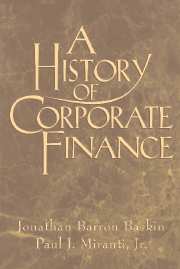Book contents
- Frontmatter
- Contents
- Preface
- Introduction: History and the Modern Theory of Finance
- Part I The Preindustrial World
- Part II The Rise of Modern Industry
- Part III The Transition to the Contemporary Era
- 6 The Financing of Center Firms, 1940–1973
- 7 Conglomerates and Leveraged-Buyout Partnerships
- Epilogue
- APPENDIX A Finance and Informational Asymmetries in the Ancient World
- APPENDIX B International Patterns of Corporate Governance
- Index
6 - The Financing of Center Firms, 1940–1973
Published online by Cambridge University Press: 22 March 2010
- Frontmatter
- Contents
- Preface
- Introduction: History and the Modern Theory of Finance
- Part I The Preindustrial World
- Part II The Rise of Modern Industry
- Part III The Transition to the Contemporary Era
- 6 The Financing of Center Firms, 1940–1973
- 7 Conglomerates and Leveraged-Buyout Partnerships
- Epilogue
- APPENDIX A Finance and Informational Asymmetries in the Ancient World
- APPENDIX B International Patterns of Corporate Governance
- Index
Summary
Introduction
This chapter focuses on the financing of what economist Robert T. Averitt, in his book The Dual Economy (1968), has termed “center firms,” which represent one of three leading classes of enterprises that figured prominently in the development of contemporary corporate finance. (The other two – the conglomerate and the leveraged-buyout partnership – are discussed in Chapter 7.) The importance of center firms from the standpoint of financial history derives from their robust industrial capacities, which have contributed strongly to national economic vitality. In evaluating center firm finance, this chapter lays greatest stress on the role of management in devising financial policies that sought to satisfy two sets of interdependent priorities. The first was functional, involving the integration of finance both in the basic procedures designed to ensure effective coordination and control of operational activities and in the strategic planning processes that are dedicated to ensuring the future profitable employment of enterprise resources. The second set of priorities was contractual, involving the definition of financial relationships to reconcile the often dissimilar interests of managers and other constituencies, such as shareholders and creditors, whose actions might impinge in important ways on the firm.
The dynamism of center firms was partly attributable to their leadership in three types of investment that were critical for industrial growth: research and development, product innovation and capital goods production. The center firms that Averitt studied were in a limited range of activities (Table 6.1). For instance, all but three of the forty-one industrial categories studied by Averitt were classified under five two-digit Standard Industrial Classification (SIC) classes: oil, rubber, chemicals, machinery and metals.
- Type
- Chapter
- Information
- A History of Corporate Finance , pp. 213 - 257Publisher: Cambridge University PressPrint publication year: 1997



